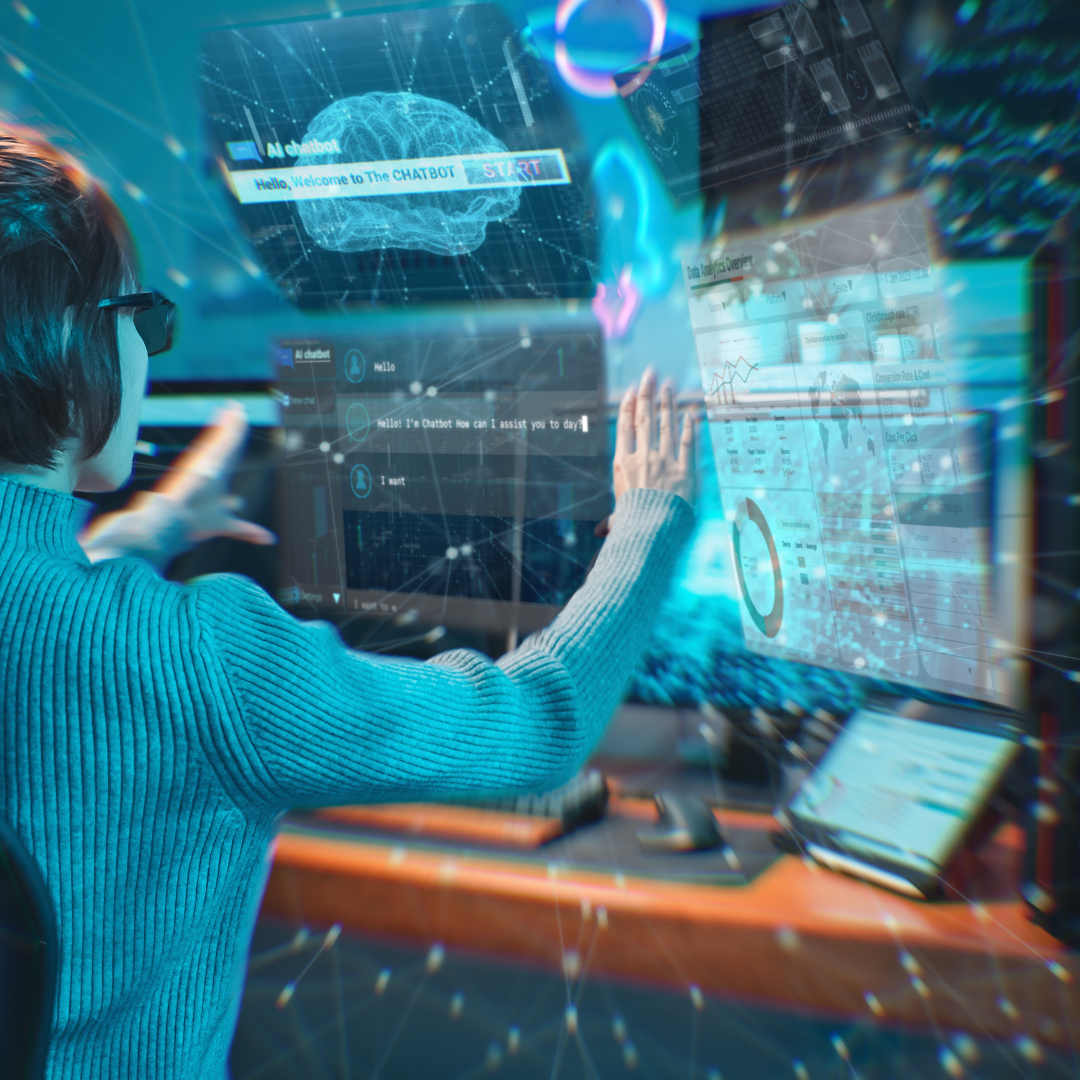AI-generated designs are everywhere. If you are active on social platforms, you’ve probably seen a variety of content that’s been created using AI tools, most commonly, DALLE. The allure of text-based tools comes from their capability to generate images solely from a string of descriptive text. What will marketing and design look like with the rise of comprehensive AI tools? Many fear that AI will replace designers, and this is somewhat true. AI will replace today's designers but will empower the designers of tomorrow. Partnering with AI will help marketing professionals and designers revolutionize the digital world and beyond.
What’s The Big Deal with Generative AI?
Generative AI is altering the course of creativity and problem-solving. Now that computers can learn from large datasets and create new data from learned patterns, AI can generate new text, images, video, code, and even music that has never been seen or heard before. Traditional AI algorithms are used to identify patterns within data sets and make predictions. Generative AI uses machine learning algorithms to create content based on data sets. Generative AI can produce outputs in the same medium in which it is prompted (text-to-text) or in a different medium from the given prompt (text-to-image). This technology opens up countless possibilities for marketers. In the creative industry, large companies like Adobe and OpenAI, as well as individual artists, are adopting AI to enrich their work. AI's power to automate repetitive tasks allows creatives to concentrate on more complex aspects, like cultivating new ideas and innovative solutions. ChatGPT is a specific implementation of generative AI designed explicitly for conversational purposes. Around 50% of businesses believe ChatGPT will contribute to improved decision-making and enable the creation of content in different languages. In addition, 30% plan to use AI for generating website copy, 41% for fixing coding errors, and 53% for summarizing information.
Designing With AI
AI has made a notable impact in the creative industry, particularly in the realm of design and artwork. One of the most striking developments is the emergence of AI-generated designs. Through generative models and deep learning algorithms, AI can assemble original content that challenges traditional creative boundaries. This novel approach has sparked interest in the creative world and also captivated audiences with its fresh output. Another promising avenue is collaborative design with AI tools. Instead of just depending on AI to develop content, creatives are now exploring ways to work together with AI.
These tools serve as clever assistants, delivering practical recommendations and expanding the creative process. The blend of human creativity and AI's data-driven insights can lead to unique and unexpected developments, pushing the boundaries of what's possible in design. AI has proven itself to be highly effective in automating repetitive design tasks. Traditionally, designers spent a considerable amount of time and effort on mundane tasks, like tweaking image sizing, color adjustments, or layout optimization. With AI algorithms, these redundant jobs can be executed efficiently, freeing designers to focus more on the imaginative aspects of their work. This not only enhances productivity but also enables them to tackle more complex challenges.
Using AI for Design Inspiration and Exploration
AI has become an invaluable tool for design inspiration and exploration, presenting a broad scope of abilities to help enhance the creative process. One of the key applications is AI-powered trend analysis and forecasting. By analyzing extensive amounts of design-related data, from user preferences to historical patterns, AI can equip designers with a new perspective on emerging trends. This gives them the insight they need to stay ahead of the curve, incorporating the latest styles and concepts into their work and ensuring their designs resonate with their contemporary audiences. AI also gives designers a starting point for projects by providing image and style recommendations. Leveraging sophisticated algorithms, AI can understand a designer's preferences and previous work to suggest relevant inspiration references. These suggestions can range from color palettes and typography to layout ideas, enabling designers to overcome creative blocks and discover fresh outlooks to improve their projects.
 By enabling designers to explore innovative concepts and aesthetics, AI elevates the creative industry. Through generative models and neural networks, AI generates novel and imaginative design variations, meaning designers can experiment with different styles, forms, and arrangements that they might not have thought originally come up with. This AI-driven exploration opens up new creative possibilities, fostering a culture of experimentation and pushing the boundaries of traditional design. However, it's important to remember that AI is a tool and not a stand-in for human creativity. The collaboration between AI and designers is essential for reaching their full potential. As AI continues to advance, its role in design inspiration and exploration will only expand, empowering designers to create even more impactful work.
By enabling designers to explore innovative concepts and aesthetics, AI elevates the creative industry. Through generative models and neural networks, AI generates novel and imaginative design variations, meaning designers can experiment with different styles, forms, and arrangements that they might not have thought originally come up with. This AI-driven exploration opens up new creative possibilities, fostering a culture of experimentation and pushing the boundaries of traditional design. However, it's important to remember that AI is a tool and not a stand-in for human creativity. The collaboration between AI and designers is essential for reaching their full potential. As AI continues to advance, its role in design inspiration and exploration will only expand, empowering designers to create even more impactful work.
Enhanced User Experience With AI
By bringing new possibilities for user-centric approaches to the table, AI has changed the way businesses interact with their audiences. AI's presence in design has ushered in a new era of user-focused creativity. In fact, over 60% of business owners believe AI will improve customer relationships. By leveraging the power of AI for user research, personalization, and recommendation systems, designers can create compelling, engaging, and seamless experiences that leave a lasting impression. Whether it's suggesting related products, articles, or design elements, AI empowers designers to create more effective and user-centric experiences. User research and usability testing stem from AI’s ability to process extended data and analyze user behavior, feedback, and interactions to extract fresh insights. This encourages creators to get to know their audience even more, identify pain points, and make informed design decisions that meet the needs of their niche audience.
By incorporating AI into user research, designers can intuitively construct more user-friendly products and experiences. By leveraging data on individual preferences, browsing history, and past interactions, AI-driven systems can tailor content and design elements to suit each individual’s unique tastes. Personalization elevates user engagement, satisfaction, and loyalty because people feel a stronger connection to products that are optimized specifically to their interests and preferences. Drawing on machine learning algorithms, AI-driven recommendation systems analyze user data to present relevant content features. By offering personalized guidance, designers can keep users engaged, reduce decision fatigue, and improve overall satisfaction. Striking the right balance between personalization and privacy is crucial to uphold trust and ethics. As AI technology advances further, its potential for elevating design practices and user experiences will continue to expand.
AI Augmented Design
By combining AI's capabilities with AR and VR technologies, the immersive and interactive elements of designs can reach new heights. AI enhances these virtual environments by adding dynamic elements, personalized content, and context-aware interactions. This fusion enables designers to craft captivating and user-centric experiences that bridge the gap between the digital and physical worlds in a way that was only dreamt about in the past. AI-powered design prototyping and visualization revolutionize design by streamlining processes and enhancing creativity.
With AI-generated design variations and rapid prototyping, designers can instantaneously explore multiple concepts and visualize them in realistic contexts at once. This allows for a more experimental approach to design. Even presenting ideas is easier with AI-driven visualization tools. These tools enable designers to better communicate their ideas to clients, providing a clearer understanding of the final product or project. As AI systems become more prevalent, designers must formulate interfaces that promote seamless interactions between users and AI algorithms. Understanding user preferences, behavior, and expectations is crucial to creating interfaces that empower the capabilities of AI. That being said, designers must balance transparency, trust, and user control to ensure AI-driven interactions are user-friendly and ethical.
Design Automation and Optimization With AI
Ethical Considerations in AI-Driven Design
While AI's integration into the creative industry brings exciting opportunities, it also raises questions about the role of human creativity and its potential impact on the job market. Striking the right balance between humans and AI assistance will always be vital. While AI can handle repetitive tasks and offer data-driven insights, human designers bring artistic vision, emotional intelligence, and the ability to think outside the box, which are indispensable qualities in the creative process. Collaboration between designers, AI experts, and businesses is essential to harness AI's full capabilities while ensuring alignment with audience needs and ethics. As AI continues to evolve, its integration with the user experience will play an increasingly influential role in shaping the future of design.
Future Trends in AI and Design
The future of AI is opening doors we didn’t know existed. AI has the potential to contribute $15.7 trillion to the global economy by 2030. The new era of AI-driven design, calls for continuous improvement. Professionals must adapt and learn to use AI to its fullest potential. By using the power of evolutionary algorithms, which mimic the process of natural selection, AI can refine and optimize designs over successive generations, pinpointing what the most efficient and innovative solutions would be. The integration of AI with generative design and evolutionary algorithms not only accelerates the design process but also opens up new creative avenues. Designers can directly collaborate with AI systems as co-creators, capitalizing on their computational capabilities to boost creativity. By assisting in combining ideas, identifying patterns, and proposing solutions that are more than what originally meets the eye leading to groundbreaking outcomes. The future of design is bright because of AI’s capacity to redefine how we approach problems, come up with solutions, and unleash our imaginations across every industry. As AI continues to evolve, it will be essential to embrace and adapt to these emerging technologies to remain in the driver's seat of innovative design.
AI is a powerful tool to unlock new levels of creativity and innovation. As AI technology continues to evolve, we can expect even more exciting applications and possibilities in the creative world. As AI continues to evolve and improve, it has the potential to help us create new and exciting content that we never thought was possible. The ongoing development of AI in design continues to reshape creative expression, fueling a dynamic landscape for every artist, designer, and audience.






